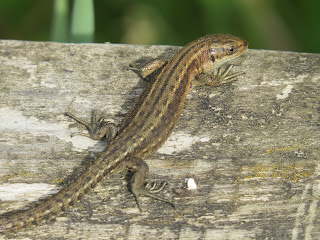Swallowtail season has begun at Strumpshaw Fen. Today, people have been turning up from all over the country. Some as far as Somerset. The weather was perfect for these beautiful butterflies, but it turned out to be a slow morning. I only managed to spot one fly past Reception Hide very briefly and that was it. A further two were spotted in the fields beside the late doctor's cottage at the other end of the reserve.
 |
| Blue-tailed Damselfly |
Not the greatest day for swallowtails then, but for other butterflies and insects, it has been a brilliant morning. Especially damselflies. I think I have seen nearly every species that I know that are out now. When it comes to damselflies, I can't say that I am a true expert on telling them apart. The obvious one is the large red damselfly, which is self explanatory, but the others are blue and can look very similar to one another. To tell them apart, you need to study the black markings very closely. Not an easy task even for an amateur expert like me. The best one that I do know with enough confidence is the red-eyed damselfly, which has, well, red eyes and loves sitting on lily pads.
 |
| Variable Damselfly |
 |
| Azure Damselfly |
 |
| Red-eyed Damselfly |
 |
| Large Red Damselfly |
 |
| Not sure. Immature Azure Damselfly? |
 |
| Jewel Wasp |
If you want to see a swallowtail, the best place to be is at the nectar garden adjacent to the Reception Hide. Its also a great place to see other things such as brimstones, orange-tips, green-veined whites, peacocks, red admirals as well as the many species of hoverfly and bee that visit the flowers to pollenate them. The centrepiece is the standing log peppered with holes for solitary bees and wasps to nest in. I love this log. There's always something to see on it during the summer months and today was no exception. There were many tiny jewel wasps checking these holes out. These small colourful wasps are like cuckoos, laying their eggs in holes used by mason bees. The wasp larvae will then hatch and feast on the bee larvae. As well as the jewel wasps, I also saw this ichneumon wasp, which injects its eggs inside another insect's larva. They hatch out within their host and feed on their insides, leaving only the vital organs, before bursting out of their host like from the movie Alien. Nature is nasty sometimes!

 |
| Ichneumon Wasp |
 |
| Peacock |
 |
| Orange-tip |
 |
| Brimstone |
 |
| Dark Bush Cricket instar |
 |
| Tree Bumblebees nesting under the tiles of the workshop building |
 |
| Cuckoo |
If the cruel habits of insects have put you off a bit, then I'd better talk about birds. During my walk before my shift, I walked down to the river and heard a male cuckoo. It sounded close and after hearing him calling a few times, I managed to locate him. He was perching at the very top of a bare branched tree on the opposite side of the river calling proudly. Then a boat passed by and caused it to fly off. I then heard it again. It sounded like it was near Fen Hide. So I went down there to find it again, only I couldn't. It was still calling though and I was able to locate it finally, perched on a bush in the distance, as I was making my way back to Reception Hide.
 |
| Yellow Flag Iris |
 |
| Common Lizard |
 |
| Kingfisher |
For those who love kingfishers, you'd be pleased to hear that at least one was showing well from Reception Hide throughout the morning. That new perching tree is proving very popular indeed. They just keep coming back to it every few minutes. Sometimes they sit on the very top, which makes them appear as part of the tree, surprising since they are so strikingly colourful. I also saw marsh harriers, a hobby, reed, sedge, Cetti's and willow warblers, whitethroats, reed buntings, a few dragonflies and some common twayblades that are now fully developed in the usual spot along the woodland trail.
 |
| Marsh Harrier |
 |
| Cobber the Black Swan |
 |
| Coot with chick |
 |
| Jay |

 |
| Common Twayblade |




































No comments:
Post a Comment